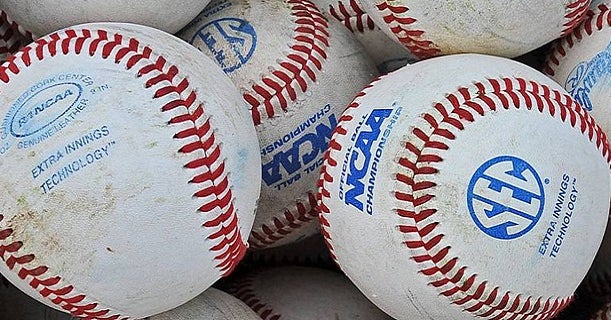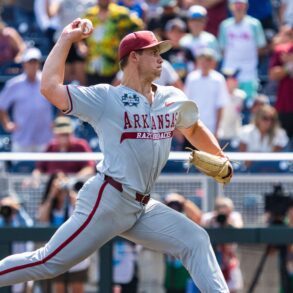
As loyal readers know, I penned a biography of Dude Noble last year. The Dude: The Life and Times of Dudy Noble has done extremely well. For that, I am grateful. One of the most surprising comments I have received over the last several months involve Dudy Noble Field. Many knew of the Diamond Dawgs’ home ball park, but did not know much about the man. Some were not even aware that Noble was a real person.
In fact, during one quest to obtain some records about Noble from the University, a student was charged with helping secure the documents. After a bit of difficulty, they asked their supervisor, “Are you sure he went to school here?”. Yes, indeed he did. In fact, Noble is the most decorated student athlete in the history of the institution. That is why you write books, to educate and entertain.
During my research for The Dude, I ran across a newspaper article about former LSU standout Alex Box. It got me to thinking about how I have been to every SEC baseball baseball park other than the two new kids, Oklahoma and Texas. We will knock OU off the bingo card this year.
While I have spent some time at the historic baseball venues in the Southeastern Conference, I have never heard many of the stories about why they are called what they are. So, here we are learning together.
Alabama – Sewell-Thomas Stadium: Locals call this park “The Joe” for former Alabama standout Joe Sewell. A product of Wetumpka High School (AL), Sewell lettered in both baseball and football during his time with the Crimson Tide. He went on to a pro career that included World Series wins with Cleveland (1920) and the New York Yankees (1932). The park was originally named Thomas Park for former Alabama coach Frank Thomas who established Alabama as a national power in football. Sewell’s name joined Thomas’s in 1978. Sewell is a member of the Baseball Hall of Fame. Thomas was also inducted into the College Football Hall of Fame.
Arkansas – Baum-Walker Stadium: The official name of the ball park is Baum-Walker Stadium at George Cole Field. For twenty years, the Razorbacks played at Cole Field. In 1996, the new stadium was constructed. It was originally called Baum Stadium for donor Charlie Baum who helped finance the project. The Walker name was later added in honor of Willard and Pat Walker who also made contributions to the erection of the stadium. The Walkers son Johnny Mike Walker was a baseball letterman in 1975. Cole is a legendary figure in Arkansas athletics history. He lettered in both baseball and football and eventually became the school’s athletic director.
Auburn – Plainsman Park: Plainsman became the official home of Tiger baseball in 1950. The official nomenclature is Samford Stadium – Hitchcock Field at Plainsman Park. That is quite a mouthful to say the least. Billy and Jimmy Hitchcock were prominent with Tiger athletic success. Jimmy became the school’s first All-American in baseball and football. Billy spent a portion of eleven seasons as a player in Major League Baseball with five teams, beginning and ending with the Detroit Tigers. Once his playing days were done, Billy went into coaching at the pro level working as a the manager of Tigers, Orioles and Braves. The Samford portion of the name was added back in 20023 in honor of longtime trustee Jimmy Samford.
Florida – Condron Family Ballpark: Gary Condron is a former Gator baseball alum. Successful in business, Condron has donated tens of millions of dollars to the advancement of Florida Athletics. When the new stadium was built in 2020 it bore the name of Condron. The field is officially named Alfred A. McKethan Field. The earlier stadium was named McKethan stadium at Perry Field. “Tootie” Perry was an All-Southern offensive lineman during his college career with the Gators. When Florida looked to build a baseball field, the Perry family donated the land where it was established.
Georgia – Foley Field: The Bulldogs have called Foley home since 1966. The venue is named after former Georgia first baseman and pitcher Judge Frank Foley. Foley was part of UGA’s first ever conference title team in 1908. After his playing days were over, he went to law school in Michigan before returning to the Peach State to set up private practice. He maintained his love and support for the Bulldogs until his death in 1966. The following year, the stadium was named in his honor.
Kentucky – Kentucky Proud Park: The current park replaced Cliff Hagan in 2018. “The Cliff” was torn down to expand the track and field facilities. The naming rights to the current stadium were donated to the Kentucky Department of Agriculture.
LSU – Alex Box Stadium – Box was a former baseball star who was killed in Tunisia during World War II. Box was also patrolling for land mines at the time of his death. LSU wasted no time in honoring him by putting his name on their stadium the following season. Skip Bertman’s name was added to the official name back in 2013.
Mississippi State – Dudy Noble Field: The full name of the most sacred patch of grass in the southland is Polk-Dement Stadium at Dudy Noble Field. Unlike most SEC venues, the field remains the more common name rather than the stadium. Noble was still athletic director at State when the Lowndes County Alumni association made a proposal to name the ball park after him. The new stadium completed in 2019 was named after legendary coach Ron Polk. The Dement name was added when Bonnie Dement donated a million dollars in honor of her husband, Gordon, who has a huge Mississippi State baseball supporter.
Missouri – Taylor Stadium: Ralph and Debbie Taylor were generous with their money when it came to Mizzou. The baseball stadium carries their name due to their generosity. The stadium surrounds Simmons Field. John “Hi” Simmons coached the Tigers from 1937 to 1973. Under his direction, Mizzou played for the national title four times winning it once (1954). Simmons is a member of the ABCA Hall of Fame along with similar honors from Missouri itself.
Oklahoma – Mitchell Park: The facility is named after Sooner baseball great Dale Mitchell. His name remains atop the Oklahoma baseball record books with a career batting average of .467. His high water mark as a Sooner senior of .507 remains the Oklahoma gold standard. Mitchell spent eleven seasons with the Cleveland Indians and Brooklyn Dodgers. He was a member of the Indians’ 1948 World Series champion team. He also played in a pair of MLB All-Star games.
Ole Miss – Swayze Field: Officially Oxford-University Stadium at Swayze field, the Rebels home park is commonly referred to as simply, Swayze. Tom Swayze lettered in both baseball and football at Ole Miss. Swayze spent 21 years as the Rebel head baseball coach, retiring as the winningest coach in school history at the time.
South Carolina – Founders Park: The stadium was built in 2009 with Founders coming on as a corporate sponsor in 2015. Prior to that, the venue was referred to as Carolina Stadium. The previous stadium was called Sarge Frye Field. A former military hero, Weldon “Sarge” Frye served as the facilities manager and grounds keeper for nearly fifty years.
Tennessee – Lindsey Nelson Stadium: A former Tennessee alum, Nelson went into broadcasting after serving in World War II. Nelson During his time with the Army, Nelson played baseball for legendary Harry “The Hat” Walker. The flamboyant Nelson founded the Volunteer Radio Network and was considered, by many, as the top college football voice in the country. He worked as the voice of the New York Mets and was affectionally referred to as “Mr. New Year’s Day”. Nelson broadcasted dozens of bowl games and became synonymous with the bowl season.
Texas – Disch-Falk Stadium: University Federal Credit Union became a corporate sponsor in 2006, but the park is called “The Disch” by Longhorns. Billy Disch served as a Longhorn baseball coach from 1911 to 1939. He won 513 games and 20 SWC league titles during his Texas tenure. Bibb Falk, an Austin native, lettered in both baseball and football. He was with the White Sox when the the Black Sox scandal broke. It was Falk who took over in leftfield after Shoeless Joe Jackson was suspended. Bibb played in the big leagues from 1920 to 1931 for both the Sox and the Cleveland Indians. Once he hung up the spikes, he managed the Indians and Red Sox for a season a piece in 1933 and 1934. Bibb returned to Texas and coached the Longhorns to a pair of national titles in ’49 and ’50. Like his predecessor, he won 20 SWC titles. Both Bibb and Falk are members of the College Baseball Hall of Fame.
Texas A&M – Olsen Field: The official name is Olsen Field at Blue Bell Park as of 2010. Recent years have found SEC fans simply referring to the Aggie home park as Blue Bell. Pat Olsen is an Aggie baseball alum who had a cup of coffee with the Yankees. His bunk mate at spring training was the legendary Lou Gehrig. Olsen did not make the cut and eventually left baseball for a life in business. Olsen was a baseball benefactor for the Aggies throughout his life.
Vanderbilt – Hawkins Field: Charles Hawkins was a baseball and football veteran at Vandy from 1952-54. Hawkins was the first Commodore named All-SEC following his final season as a pitcher. Hawkins was a long time financial supporter of Vanderbilt even donating $2 million to complete the current stadium.
This post was originally published on this site be sure to check out more of their content.








